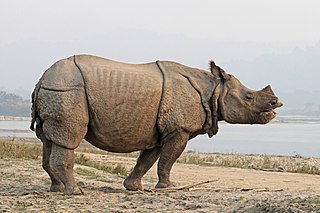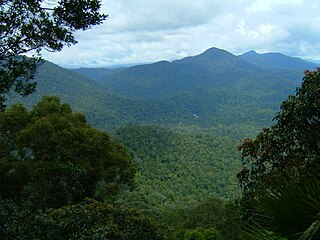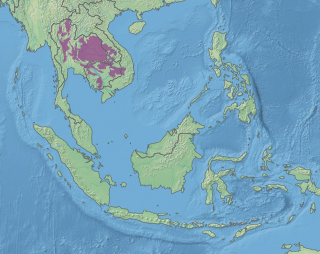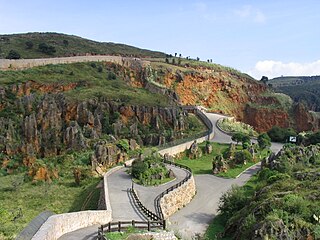
The common warthog is a wild member of the pig family (Suidae) found in grassland, savanna, and woodland in sub-Saharan Africa. In the past, it was commonly treated as a subspecies of P. aethiopicus, but today that scientific name is restricted to the desert warthog of northern Kenya, Somalia, and eastern Ethiopia.

The Javan rhinoceros, also known as the Sunda rhinoceros or lesser one-horned rhinoceros, is a very rare member of the family Rhinocerotidae and one of five extant rhinoceroses. It belongs to the same genus as the Indian rhinoceros, and has similar mosaic, armour-like skin, but at 3.1–3.2 m (10–10 ft) in length and 1.4–1.7 m (4.6–5.6 ft) in height, it is smaller. Its horn is usually shorter than 25 cm (9.8 in), and is smaller than those of the other rhino species. Only adult males have horns; females lack them altogether.

The flehmen response ; from German flehmen, to bare the upper teeth, and Upper Saxon German flemmen, to look spiteful), also called the flehmen position, flehmen reaction, flehming, or flehmening, is a behavior in which an animal curls back its upper lip exposing its front teeth, inhales with the nostrils usually closed, and then often holds this position for several seconds. It may be performed over a sight or substance of particular interest to the animal, or may be performed with the neck stretched and the head held high in the air.

The Sumatran rhinoceros, also known as the hairy rhinoceros or Asian two-horned rhinoceros, is a rare member of the family Rhinocerotidae and one of five extant species of rhinoceros. It is the only extant species of the genus Dicerorhinus. It is the smallest rhinoceros, although it is still a large mammal; it stands 112–145 cm (3.67–4.76 ft) high at the shoulder, with a head-and-body length of 2.36–3.18 m (7.7–10.4 ft) and a tail of 35–70 cm (14–28 in). The weight is reported to range from 500 to 1,000 kg, averaging 700–800 kg (1,540–1,760 lb), although there is a single record of a 2,000 kg (4,410 lb) specimen. Like both African species, it has two horns; the larger is the nasal horn, typically 15–25 cm (5.9–9.8 in), while the other horn is typically a stub. A coat of reddish-brown hair covers most of the Sumatran rhino's body.

A rhinoceros, commonly abbreviated to rhino, is one of any five extant species of odd-toed ungulates in the family Rhinocerotidae, as well as any of the numerous extinct species therein. Two of the extant species are native to Africa, and three to Southern Asia. The term "rhinoceros" is often more broadly applied to now extinct species of the superfamily Rhinocerotoidea.

The Indian rhinoceros, also called the greater one-horned rhinoceros and great Indian rhinoceros, is a rhinoceros species native to the Indian subcontinent. It is listed as Vulnerable on the IUCN Red List, as populations are fragmented and restricted to less than 20,000 km2 (7,700 sq mi). Moreover, the extent and quality of the rhino's most important habitat, the alluvial Terai-Duar savanna and grasslands and riverine forest, is considered to be in decline due to human and livestock encroachment. As of 2008, a total of 2,575 mature individuals were estimated to live in the wild.

Jaldapara National Park is a national park situated at the foothills of the Eastern Himalayas in Alipurduar District of northern West Bengal and on the banks of the Torsa River. Jaldapara is situated at an altitude of 61 m and is spread across 216.51 km2 (83.59 sq mi) of vast grassland with patches of riverine forests. It was declared a sanctuary in 1941 for protection of its great variety flora and fauna. Today, it has the largest population of the Indian one horned rhinoceros in the state, an animal threatened with extinction, and is a Habitat management area. The nearby Chilapata Forests is an elephant corridor between Jaldapara and the Buxa Tiger Reserve Near by is the Gorumara National Park, known for its population of Indian rhinoceros.
64 Zoo Lane is a British-French children's cartoon created by English author An Vrombaut. The series was produced by Millimages, Zoo Lane Productions, and La Cinquième. The first two seasons aired from 1999 to 2003. After a seven-year break, the show returned in 2010 for another two seasons, ending in 2013. 104 total episodes were produced.

Endau-Rompin National Park is a protected tropical rainforest in the southernmost prolongation of the Tenasserim Hills, Malaysia. It is south of the state of Pahang and northeast of Johor covering an area of approximately 870 km2 (340 sq mi), making it the second-largest national park in Peninsular Malaysia after Taman Negara. It has approximately 26 km (16 mi) of trail. It is the second national park proclaimed by the government of Malaysia. Gunung Besar, the second-highest peak in Johor, is in the park.

Edward Cross was an English zoo proprietor and dealer in animals.
Sarcocystis is a genus of parasitic Apicomplexan alveolates. Species in this genus infect reptiles, birds and mammals. The name is derived from Greek: sarkos = flesh and kystis = bladder.

The Central Indochina dry forests are a large tropical and subtropical dry broadleaf forests ecoregion in Southeast Asia.
The Mammalia in the 10th edition of Systema Naturae forms one of six classes of animals in Carl Linnaeus's tenth reformed edition written in Latin. The following explanations are based on William Turton's translations who rearranged and corrected earlier editions published by Johann Friedrich Gmelin, Johan Christian Fabricius and Carl Ludwig Willdenow:
Animals that suckle their young by means of lactiferous teats. In external and internal structure they resemble man: most of them are quadrupeds; and with man, their natural enemy, inhabit the surface of the Earth. The largest, though fewest in number, inhabit the ocean.

Cabárceno Natural Park is a zoo in a former iron mine in the town of Cabárceno, 17 kilometres (11 mi) south from Santander. The park belongs to Cantur, a company owned by the Government of Cantabria, whose purpose is the promotion of tourism.

The existence of rhinoceroses in ancient China is attested both by archaeological evidence and by references in ancient Chinese literature. Depictions of rhinoceroses in ancient Chinese art are typically very accurate and lifelike, suggesting that they were modelled first-hand by the artist on living rhinoceroses rather than being based on legend or traveller's tales. The main species of rhinoceros that lived in China in ancient times has been identified as the Sumatran Rhinoceros, more especially the Northern Sumatran rhinoceros although the Indian Rhinoceros and Javan Rhinoceros were also present.

Comfort behaviours in animals are activities that help maintain the pelage, feathers, integuement or musculoskeletal system and increase the physical comfort of the animal.

Self-anointing in animals, sometimes called anointing or anting, is a behaviour whereby a non-human animal smears odoriferous substances over themselves. These substances are often the secretions, parts, or entire bodies of other animals or plants. The animal may chew these substances and then spread the resulting saliva mixture over their body, or they may apply the source of the odour directly with an appendage, tool or by rubbing their body on the source.

The Bornean rhinoceros, also known as Eastern Sumatran rhinoceros or Eastern hairy rhinoceros, is one of the three subspecies of Sumatran rhinoceros. In April 2015, the Malaysian government declared the Bornean rhinoceros to be extinct in the wild in the Malaysian portion of Borneo, with only two individuals left in captivity in the state of Sabah. However, in March 2016, a young female rhino was captured in East Kalimantan, providing solid evidence of their continued existence. The International Union for Conservation of Nature (IUCN) classifies the subspecies as critically endangered.


















